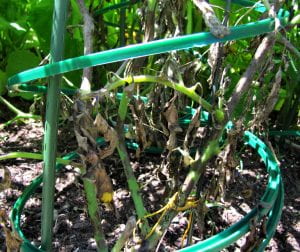This page was written in 2011 in the middle of a 6 year period when late blight occurred every year on Long Island with first observations in early summer, source of the pathogen was known or suspected to be garden plantings, impact on commercial production was great, and late blight was occurring widely in the northeast increasing the potential for the pathogen to be in potato tubers. Since then probability of the pathogen being in potatoes has decreased with decline in late blight occurrence in the USA; however, it remains possible.
Planting potatoes in your garden this season is a lot like playing Russian Roulette. True, the chances that the seed potato you plant will be infected with late blight are slim. (Less than one in 100 for the potato, compared to one in six for the revolver.) But late blight is such a contagious and devastating disease of tomatoes as well as potatoes that you have to ask yourself: Are a few home-grown potatoes worth the risk of killing all your tomatoes, not to mention the possibility of spreading the disease to other gardens and farms?
There are valuable steps that that you can take to reduce the risk of bringing late blight into your garden on potatoes, but it is important to realize it is impossible to eliminate the risk completely. The most important step: Plant certified seed potatoes, rather than potatoes saved from last year’s garden or purchased at a grocery store. You should also destroy any volunteer potatoes that may have sprouted from tubers unharvested last season or in the compost pile.
Certification does not mean there will be no blighted tubers in the lot, however. The late blight pathogen has been detected this year in some seed potato lots. The incidence is well below the tolerance of 1%. Is that a low enough probability to be worth taking the chance?
The next step is to thoroughly examine tubers and only plant those that appear healthy. However, symptoms of late blight on the surface of a tuber can be difficult to identify and infested tubers may not have any surface symptoms at all.
There is concern that seed potato tubers harboring a so-called tomato genotype (strain) are more likely to be a source of the pathogen for plants than seed potatoes with a potato genotype. Tomato genotypes, which are more aggressive on tomato than potato, have been responsible for most late blight outbreaks on tomato recently, most notably in 2009. Seed potatoes infected with the tomato genotype are less likely to rot in storage overwinter, and their sprouts are less likely to be killed by late blight as they emerge.
Is it better to only grow tomatoes in your home garden, thereby avoiding this risk, and turn to local farmers for the next best thing to a home-grown potato? Farmers generally have more experience managing late blight in potatoes than gardeners do. And, like medical doctors, they have access to more effective ‘medicines’ for this disease (e.g. fungicides) because they have completed the training required to use them.
Passing on potatoes this season will reduce the risk of late blight developing in your garden, but it does not eliminate this risk because the causal pathogen produces spores that are dispersed easily by wind. If windborne spores land on tomatoes, late blight almost certainly will develop as conditions are often favorable (humidity at least 90%) while the spores are alive.
There are additional steps you can take to minimize the possibility of late blight killing tomatoes in your garden. There are now tomato varieties with resistance to late blight. And there’s now a nationwide late blight tracking system so that gardeners and farmers can monitor where this disease is occurring in the U.S. (Visit:http://usablight.org). Gardener participation in the reporting system will be critical. Some of the first occurrences in 2010 were in gardens. Also, project researchers will want samples to identify the responsible pathogen’s genotype.
Click on images for a larger view.
View more late blight images and factsheets: Tomato | Potato
Gardeners spotted late blight symptoms at this community church garden on Long Island, N.Y. (above), on June 16, 2010, five days before these photographs were taken. They immediately submitted a sample to their local Cornell Cooperative Extension diagnostic clinic and then promptly destroyed affected plants when late blight was confirmed. They put the plants in garbage bags and left them where the sun could heat the contents and hasten death of the plants and pathogen. There were no other outbreaks of late blight in this area in 2010, thus the gardeners acted fast enough to prevent spread.
Tomatoes not yet removed are severely affected, attesting to the speed with which late blight can develop.
Close-up shows characterstic dark brown lesions on stems.
A few potatoes planted in the garden were the most likely source of the late blight pathogen for this outbreak. Other possible sources were ruled out. Survival in unharvested infested potato tubers from the previous year was not possible because this is a new garden. There were no other outbreaks in the area that could have been the source of wind-dispersed spores, and with this source there should have been other gardens affected. And if the source was a tomato plant infected when purchased, it is highly unlikely it was the only infected plant and thus this would not have been the only garden affected.
View more late blight images and factsheets: Tomato | Potato






